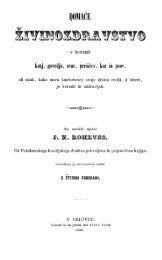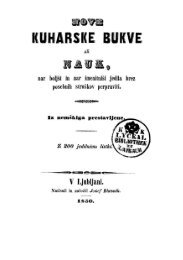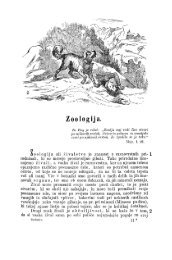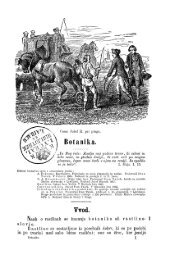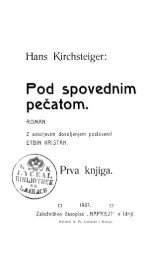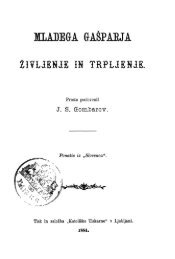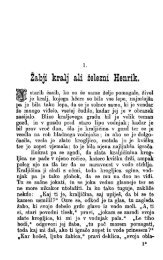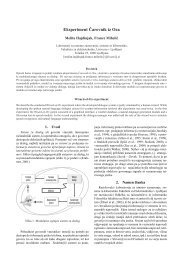Proceedings - Natural Language Server - IJS
Proceedings - Natural Language Server - IJS
Proceedings - Natural Language Server - IJS
You also want an ePaper? Increase the reach of your titles
YUMPU automatically turns print PDFs into web optimized ePapers that Google loves.
ontology. OntoGen is a semi-automatic and data-driven<br />
ontology editor. Semi-automatic means that the system is<br />
an interactive tool that aids the user during the topic<br />
ontology construction process. Data-driven means that<br />
most of the aid provided by the system is based on the<br />
underlying text data (document corpus) provided by the<br />
user. The system combines text mining techniques (Kmeans<br />
document clustering) with an efficient user<br />
interface to reduce both the time spent and complexity of<br />
manual ontology construction for the user.<br />
3. Topic ontology on raw documents<br />
We first examined how the topic ontology looks like if we<br />
do not perform any additional cleaning of the corpus. In<br />
this case, the text documents in the named-line format<br />
consist of an ID, followed by a title, names of the authors,<br />
main text of the article and references.<br />
OntoGen uses K-means clustering, i.e. a method of<br />
cluster analysis which aims to partition N instances<br />
(documents, in our case) into K clusters in which each<br />
instance belongs to the cluster with the nearest mean. If<br />
we build a topic ontology automatically, by only<br />
suggesting to OntoGen the number K of concepts at each<br />
node of the concept hierarchy, the result for the English<br />
articles can be seen in Figure 1. For every concept, we<br />
tried different K-values and chose the one that splits the<br />
concept in the best way according to the user’s<br />
understanding of the area. Neither the active learning<br />
functionality nor the renaming of the concepts was<br />
performed in this topic ontology construction process.<br />
As one can see from the figure, names of the<br />
concepts/topics are not intuitive, and in some cases it is<br />
hard to understand what they represent. This happens<br />
since for concept naming OntoGen selects the first three<br />
most frequent words from the automatically constructed<br />
keywords list. For example, if the concept is described by<br />
the following keywords: slovenian, translation, vowel,<br />
speakers, synthesis, speech, corpus, tagging etc., OntoGen<br />
will name this concept “slovenian, translation, vowel”.<br />
A better way of naming concepts is by involving the<br />
expert who can quickly find an appropriate concept name<br />
after observing all the topic keywords. Using this<br />
approach, the previous topic could be called Speech<br />
technologies. All the concepts in the English and Slovene<br />
topic ontologies were thus manually renamed based on the<br />
automatically extracted topic keywords.<br />
Next, we observed that several topics/concepts were<br />
not present in the topic ontology. For the terms often<br />
occurring in the keyword lists of different concepts, but<br />
not being one of the three main topics keywords, we<br />
decided to use the supervised method for adding topics. It<br />
is based on the Support Vector Machine (SVM) active<br />
learning method of OntoGen. For the English corpus, we<br />
entered queries for Speech recognition and Speech<br />
translation concepts and answered some automatically<br />
proposed questions of a type: Would you classify the<br />
document number 41 as an article on the topic of Speech<br />
recognition? which enabled the system to label the<br />
instances. After the concept node was constructed, it was<br />
added to the ontology as a sub-concept of the selected<br />
concept, in our case, as a sub-concept of the Speech<br />
technologies concept. Similarly, we performed active<br />
learning also on the Slovene corpus. We entered queries<br />
for Prevajanje govora (Speech translation). In this way<br />
we tried to identify the most common and important<br />
words for the missing subconcept and put them in the<br />
query. Then, as for English articles, we answered several<br />
questions, and a new sub-concept was added in the<br />
Slovene topic ontology.<br />
After manually renaming the concepts, using active<br />
learning for adding concepts, and manually moving some<br />
documents from one concept to another, we got an<br />
improved topic ontology. The resulting English topic<br />
ontology is shown in Figure 2. This ontology is more<br />
intuitive and understandable. One can see from the figure<br />
that language technologies consist of Computational<br />
linguistics and Speech technologies as its core concepts.<br />
This is also the general division of the field of language<br />
technology (e.g. in Wikipedia, language technology is<br />
defined as follows: <strong>Language</strong> technology is often called<br />
human language technology (HLT) or natural language<br />
processing (NLP) and consists of computational<br />
linguistics (or CL) and speech technology as its core but<br />
includes also many application oriented aspects of them.).<br />
Fig. 1: English topic ontology without cleaning text document and without concepts renaming.<br />
174




